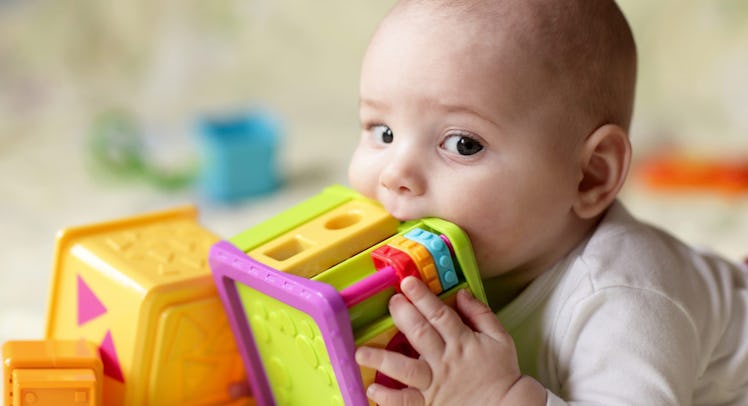My Baby’s Expensive Toys Are Cool, Safe, and Numerous, But He Won’t Play With Them
My son has cool toys, but he keeps playing with a purple pitcher. I decided to find out why.

My one-year-old baby won’t play with any of his toys.
We bought him a fancy, talking dump truck that cheers when you thrust plastic balls into its head. He prefers to throw it across the room. We bought him a lawnmower that emits bubbles when you push it. He chews on the handle. My kid is happiest when he’s opening and closing doors, running from one end of the house to the other, and using his thumb and index finger to pick up small objects that he either puts in his mouth or drops, with a satisfying clunk, into the only toy he truly enjoys—a purple water pitcher he pilfered from one of our cabinets weeks ago (and has since refused to return).
It’s perfectly normal says Anne Zachry, a professor of occupational therapy at the University of Tennessee Health Science Center who focuses on appropriate play for children. “A one-year-old is beginning to stack blocks to build a tower and typically enjoys placing items into a container and removing the items,” she says. “He uses his thumb and index finger to grasp small items, but has difficulty using his fingers and hands for manipulation.” That’s my boy!
Given that my developmentally average one-year-old prefers simple building blocks and water pitchers to fancy doo-dads and spinning octopi, I find myself wondering why I paid so much money for so much plastic. Why do I have all these lightly gnawed, high-tech baby toys? He’s got a baby cell phone that he smashes into the table (I know the feeling, kiddo), and an interactive baby flashlight he’s been trying to masticate since the six-month mark. I’m happy to spend money on toys if they make him happy or help him figure out how his fingers work, but I’m not sure I’ve made great choices. I’m not sure other people have either.
I mean, there’s a guy selling fidget spinners customized for three-year-olds, surely a prank on those with limited proprioception.
The science suggests that infants are actually better off with toys that, as Zachry puts it, “encourage exploration.” When their playpens are full of complicated, state-of-the-art items, tykes will still gravitate toward empty cups and open doors, pausing only briefly to chew on the most expensive things they own. This is just one good reason for me to invest in stuff my son can pull around the house by a drawstring or drop into his purple pitcher. The kid is not brand conscious or pretentious about play. He’s down with wooden blocks and Zachry says that should come as no surprise to anyone. Wooden blocks are great.
Then Zachry levels with me.
“I’m not a fan of ‘smart toys,'” she admits. “If it requires batteries, it’s probably not the best toy choice.”
Besides the fact that most one-year-olds don’t find that sort of thing stimulating, Zachry says, even those who do manage to figure out how to operate such toys are unlikely to benefit from playing with them. “Babies are supposed to be learning during play, but toys like this don’t require problem-solving or promote brain development,” she says.
I will caveat that statement by say it’s debatable, depending on the toy. On the one hand, studies have shown that kids who play with simple toys like blocks have improved reading and mathematics abilities later in life. On the other hand, I suppose a one-year-old could productively engage with some battery-operated toys. I may have called out the spinning octopus that tosses balls around the house, as a paradigm of age-inappropriate excess—but I can imagine my son scrambling around the house chasing plastic balls and carefully plopping them into his pitcher. That could totally happen. It hasn’t, but it could. As long as babies are exploring with their fancier, battery-operated toys, and not simply staring mesmerized, perhaps they’re not so bad.
And for parents who are tired of chasing rogue blocks all day, more advanced toys can spice-up playtime. For now, I’m happy to help my son unload and reload his purple pitcher, but the process will eventually drive me mad. However, put the two of us in front of a plasticine workbench or a singing truck and I’m good to go for a while. My son won’t know how to use the screwdriver, but he’ll probably enjoy how it tastes before putting it where it belongs, in the pitcher.
This article was originally published on